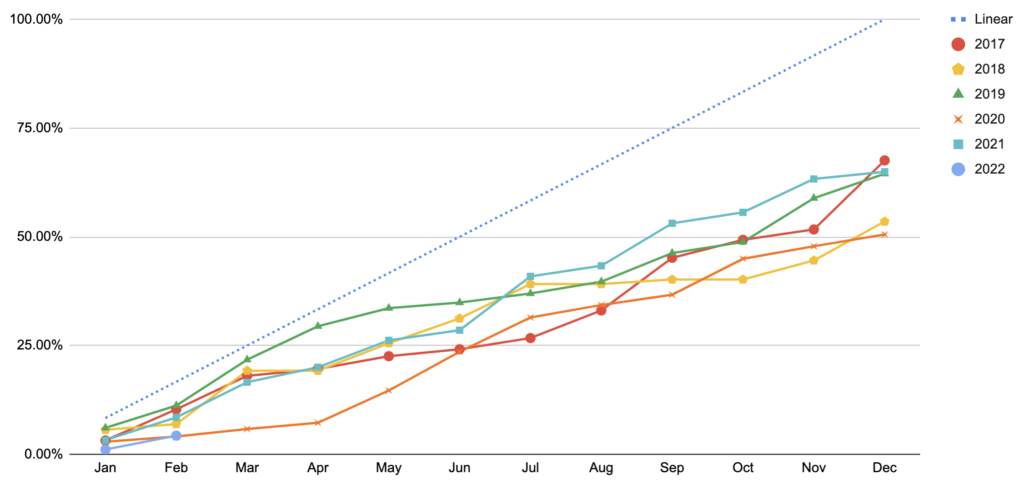
A new year can bring excitement and hope for improvements. It’s easy to set ambitious resolutions, but we all know that success depends much more on how well you execute your ideas. How many of your goals have you completed after a couple of months? If you haven’t achieved what you had hoped at this point, you’re not alone. In this article, I share my own experience with tracking goals to help ease some of your anxiety and keep you away from giving up.
Completion is non-linear
I’ve been setting resolutions and tracking their completion for over ten years. The chart below shows my completion % for each month in the last five years. For readability reasons, I preferred not to include in this chart the data from 2012 to 2016, but I considered them for my analysis. The dotted line shows what the completion % would be if it were a linear function with 100% by Dec.
The results over these years ranged from 46.74% (2012) to 67.56% (2017). After analyzing the data, I could identify a few interesting patterns:
- The completion rate was never linear and never evenly distributed: 2021 was the closest year to being linear. 2019 followed an S-shape. The median month-to-month variance was 5.13% (min = 0% and max = 15.88%) while an even distribution would expect 8.33%.
- High completion by January was not a good indicator of high annual completion: The year (2019) with the highest completion in Jan was only the fourth one with the highest annual rate (64.49%). The second-highest Jan completion (in 2018) turned out to be the second-worst year completion (53.51%). Similarly, low completion in January was not a good indicator of a low annual rate.
- Low completion by February was a better indicator for low annual completion: 2020 had the lowest completion rate in Feb and finished with the lowest year rate. The same happened for the second-lowest – 2018 – when it closed in Feb with 6.93% and in Dec with 53.51%. So far, my 2022 rate is only at 4.27%. It’ll be interesting to check in Dec this year if the Feb rate is a valid indicator.
100% is not realistic
By design, I’m not trying to reach 100%. I group my goals into personal and professional ones. On average, I set 25 goals per year.
Within a group, I also identify if goals are 1) high-priority (land major benefits to me or my family and should be fully completed) or 2) stretch (still important, but I’m not going to dread if their completion rate is lower). This strategy challenges me while keeping the anxiety and stress at low levels. I could be aggressive, shoot for 100%, and put in the work to get them done. However, that’s not the point. I set goals to improve my life instead of hitting a number.
How you write your goals matters
Which one would be your pick?
- Read 24 books per year;
- Read two books per month.
And what about this?
- Work out three times a week;
- Work out 12 times a month.
If you’re tracking your goals monthly, you should write them in a way that leads to success. While reaching numbers is not the point, they can boost or deplete your motivation to keep going. It should also be clear what the benefit is of completing a goal.
In the first example, reading 24 books per year is better than reading two books per month. Lengthy books can take longer than a month to read. The benefits of reading (have fun, learn, or whatever you’re looking for) aren’t time-sensitive. You should claim that you accomplished 1/12 of your goal when you finish a book instead of thinking you failed to complete 1/12 of it for not reading a book in a given month.
In the second example, you’re more likely to achieve the benefits of working out (being healthier, feeling replenished, and so on) by spreading the exercises throughout the month. Even though it’s harder to have the discipline to work out three times a week, it would be a more appropriate goal than working out 12 times a month. You could hit the target, for instance, by frontloading the workouts at the beginning of the month, but that would defeat the actual purpose of it.
Conclusion
- Goal achievement is not linear over the year, we will have bad months, but that shouldn’t be a reason to give up.
- Set challenging goals but don’t expect to meet all of them. Set stretch goals knowing that you most likely won’t fully achieve them.
- Break down your goals in meaningful chunks that could be accomplished over the year. Review how you wrote them and keep in mind the reason behind pursuing them.
- Be honest with yourself but don’t be harsh.






